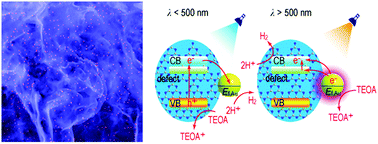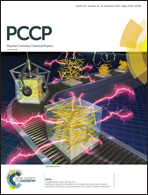Understanding the roles of plasmonic Au nanocrystal size, shape, aspect ratio and loading amount in Au/g-C3N4 hybrid nanostructures for photocatalytic hydrogen generation†
Abstract
Hybrid photocatalysts containing plasmonic metal and semiconductor building blocks can alleviate charge carrier recombination and broaden the range of light absorption of the semiconductor. In this work, plasmonic Au nanocrystals of different sizes and shapes (spheres and rods) are attached on graphitic carbon nitride (g-C3N4) nanosheets through electrostatic attraction. The effects of the morphology and loading amount of the Au nanocrystals are carefully studied for understanding and optimizing the hybrid photocatalysts. The optimized 18 nm-sized Au nanospheres/g-C3N4 photocatalyst exhibits a superior activity for H2 evolution at a rate of 540 μmol g−1 h−1 under visible light (λ > 420 nm), exceeding those produced over larger-sized Au nanospheres/g-C3N4, Au nanorods/g-C3N4 and photodeposited Au nanoparticles/g-C3N4 photocatalysts. The excellent activity for H2 evolution is attributed to the electron sink and plasmonic effects of the Au nanocrystals in different spectral regions, as evidenced by photocurrent measurements. The introduced plasmonic Au nanocrystals not only enhance the photocatalytic activity, but they also endow the hybrid photocatalysts with an extended light absorption range. Our results and understanding will be useful for the design of efficient plasmonic photocatalysts for solar to fuel energy conversion as well as for other plasmon-driven chemical reactions.



 Please wait while we load your content...
Please wait while we load your content...